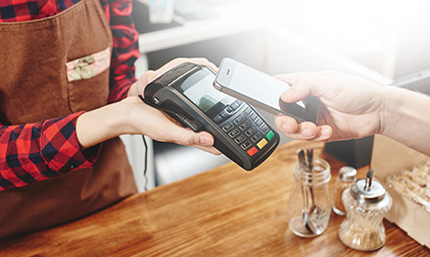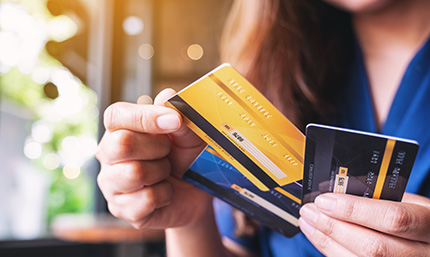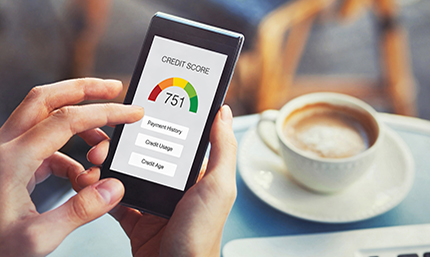News & Tips
Visa® Platinum Benefits: A Guide to Receiving Credit Card Rewards

Credit card usage is an important part of modern life. It’s a quick, easy, and convenient way to make purchases, reserve hotel rooms and rental cars, keep a record of financial transactions made, and much more. Credit cards come with consumer protections, and they allow you to combine your purchases for goods and services—from groceries to utilities—into a single monthly payment.
They can also give you peace of mind if an emergency arises, such as an unexpected car or house repair, because you’ll have a way to pay for what you need. When it’s time for holiday shopping or a vacation, their versatility allows you to cover these expenses, too.
Credit cards truly are a flexible way to manage your money. Keep reading for an overview of even more benefits of their use, plus information about credit card rewards, how to choose the right low rate credit card for your needs, applying and getting approved, and so much more—including the reason why the Visa® Platinum credit card at SCCU may be the one for you.
You can apply for your Visa Platinum at SCCU today!
Reasons to Use Credit Cards
Not that long ago, it wasn’t unusual for a cashier to ask a shopper, “Will that be cash or charge?” The decision was fairly straightforward, but today, strategically selecting whether or not to use a credit card and which one to use can be part of savvy financial management. Here are several benefits of using credit cards.
#1 Safety and Security
In a nutshell, when you carry a credit card while shopping, this reduces the need to carry cash, which if lost or stolen, can be gone for good. If someone steals a check and uses it, then you may first learn of this theft when legitimate payments bounce. It can take time for this matter to be investigated and late payments can impact your credit score.
If your credit card is lost or stolen, though, you can simply contact the financial institution and let them know. Even if a thief fraudulently uses your card, you don’t need to pay for those transactions while the matter is being investigated and resolved. At SCCU, for even quicker peace of mind, you can turn your cards “on” and “off” with the Card Control companion app, downloadable through the SCCU Mobile app.
Plus, if you want a refund for a purchase made with your credit card or for a service that you’ve found unsatisfactory, the credit card company may help you resolve challenging issues.
#2 Grace Periods
When you pay cash to purchase something, that money is immediately gone. With a debit card, it’s quickly gone, and when writing a check, the “float” period—the time frame between when you write the check until it clears the financial institute—is getting shorter and shorter.
However, with a credit card purchase, funds stay in your account until it’s time to pay your bill with credit card payments due by a certain date each month. If you earn interest on your checking account, even a small amount, this allows you to earn some during your grace period.
#3 Credit Scores
Making your payments on time can contribute to a healthy credit score. Plus, if you’re looking to establish a credit history, according to Experian (one of the three major credit bureaus in the United States), “Credit cards are one of the best credit-building tools available.”
If you already have a credit card, Experian notes that requesting a credit limit increase could help your utilization score (ratio of your outstanding balance to your credit limit), but it makes sense to explore the pros and cons of this strategy before moving forward.
#4 Credit Card Rewards
Another key benefit of credit card use is credit card rewards (such as cash back vs points). Before we delve into more specifics, here’s a quick overview of how credit card rewards came to be.
History of VISA—and of Credit Card Rewards
During the 1930s through the 1950s, individual stores would sometimes offer “charge cards” or “charge plates” that allowed shoppers to make purchases and wait until a bill arrived to pay for them. If someone wanted to charge items at three different department stores, they’d have to have an individual account with each one of them.
In 1958, Bank of America debuted what’s typically called the first universal credit card—BankAmericard. Consumers could receive a paper card that entitled them to spend up to the $300 limit at any place that accepted them as a form of payment. Bank of America mailed these cards to 60,000 people in the Fresno, California, area and they served as “revolving” credit accounts.
Because the card was revolving, people could continue to make purchases with the card as long as they made a minimum monthly payment, even when they carried an outstanding balance on the card. (In general, financial institutions require revolving credit card payments to be a certain percentage of the balance.)
In 1973, Bank of America—now called National BankAmericard Inc.—created an electronic authorization system and then a digital clearing system. The following year, the credit card went global, renamed as Visa in 1976 because it sounds the same in just about any language.
In 1997, just thirty-nine years after Visa launched under pretty humble circumstances, usage volume reached one million dollars. In 2001, four billion people had a Visa card.
By the time the 1980s arrived, consumers could choose from a variety of credit card types. To differentiate themselves and appeal to people who could pick which card to use, credit card companies issued the idea of a premium card with benefits. This, naturally enough, led to rewards programs. Note that some of these cards come with an annual fee while others are free.
Benefiting From Credit Card Rewards
Credit cards that come with rewards can each have their own unique structure. Overall, though, an account that comes with credit card rewards will incentivize account holders when they choose to use the credit card.
Focusing on cash back cards—which is what SCCU’s Visa Platinum offers—users earn a certain amount of cash back (calculated as a percentage) when they make qualifying purchases.33 When users receive cash back credits, they can use them in flexible ways within the definition of the credit card program. Learn more about why Visa Platinum is the best cash back credit card here.
Getting Approved for a Credit Card
When someone applies for a credit card, the application then goes to an underwriter. This is a person or committee who reviews the person’s financial picture as well as their credit scores to decide how much of a risk they would be. The underwriters compare that to the levels of risk that they’re willing to make —and then they approve with a beginning interest rate and certain terms, or they deny the application.
A person’s credit scores are a significant factor in a typical underwriting decision. When the scores are high, they are more likely to get approved, and at a better rate. If the scores are below optimal, the credit card may be approved, but at a higher rate. If they fall outside the parameters that the underwriter uses, the application will likely be denied.
If you’d like to check your credit reports (not your scores, your reports), you can get an official copy from Equifax, Experian, and TransUnion at AnnualCreditReport.com. As the domain name implies, this opportunity is typically available once a year at no cost. Because of COVID, at the time of writing, consumers can get free weekly reports. If you find errors that could be harming your credit, correct them with each of the bureaus.
Note that, when you have a Visa Platinum from SCCU, you are entitled to a free FICO® Score. This is the credit score that lenders often use with scores ranging from 300 to 850 (with higher one being better) to help determine someone’s credit worthiness. Our credit score worksheet can help you to keep track of your numbers.
Although credit scores are a significant factor in an underwriter’s review of a credit card application, there are others. Your monthly income and outstanding debt, particularly your mortgage or rent payment, typically play a role.
Credit Score Issues
If you find that your current credit situation is preventing you from getting the credit card you want, you may be able to get one with the help of a cosigner. This person agrees to take on the responsibility of making payments if you don’t.
Ways to rebuild your credit, according to Experian, include to catch up any past due balances and make all payments on time going forward. It can help to set up automatic payments to ensure that they don’t get missed.
Your credit utilization ratio matters, too. So, try to keep your usage to less than 30% of your credit card limit. For example, with a limit of $2,500, the balance would need to be under $750. Be careful when closing a credit card because this changes your utilization score and means that balances will need to be lower on other credit cards to stay under the 30% benchmark.
Credit Cards and Financial Management
Since 1958, revolving credit cards have allowed users to maintain a balance on their accounts each month with only a minimum payment due by the designated date. This feature makes credit card use especially convenient. For example, if you’re making a larger purchase—let’s say a new computer and printer—then you can pay for it over time.
Having said that, interest will be charged on the remaining balance (unless, as an exception, you’re within a 0% introductory period) and that means you’ll pay more, overall, for the computer and printer. When you can pay off your balance each month, this prevents you from needing to pay that interest and from taking on too much debt. Credit card usage, overall, should complement your household budget for optimal financial management.
When you use the SCCU Mobile app or our Online Banking account, you can set your own budget to help you manage overspending. You can even use the SCCU Card Control companion app to set personalized spending limits to further enhance your financial wellness. This budgeting worksheet can also be a helpful tool.
SCCU offers Visa® Secured credit cards, which help members build or improve their credit, and Visa® Student credit cards for students to help them build credit as well.
A Look at Limits
It’s a good idea to have a credit card that comes with ideal limits for your situation. Often, a financial institution will offer different tiers of cards with each having their own parameters, including their spending limits. At SCCU, the Visa Platinum limit will depend upon multiple factors, which can include your personal credit and creditworthiness at application time.
So, what is the ideal credit card limit? That may vary widely, depending upon the situation of the account holder. In general, this amount should provide you with enough credit for your needs with the card strategically used to benefit from credit card rewards without the person accumulating too much debt.
Interestingly enough, increasing your credit limit on a card (whether because of an automatic adjustment made by the financial institution or through a request from you that gets approved) can help to boost your credit scores—given that overspending doesn’t occur.
Here’s how that works. Maintaining a proper utilization ratio (spending less than 30% of your credit limit) can improve your credit scores. So, if the credit limit goes up and your spending doesn’t, this lowers your credit utilization score. If this causes your score to increase, this can help you to get better interest rates on home mortgages, car loans, and more because lenders reward higher credit scores.
To find out your SCCU Visa Platinum limit, you can apply for your Visa account here.
Choosing the Right Credit Card
Once it’s time to apply for a credit card, people typically want a:
- low rate credit card
- credit card limit that suits their needs
- rewards program that links to their card usage
Some credit cards come with a special introductory rate, perhaps even with a 0% APR for a short time. People may decide to apply for this type of credit card and transfer balances from high interest credit cards to this one. If this is your strategy, make sure that balance transfers are allowed and check to see if there’s a balance transfer fee. If the lender will charge a fee, then this may negate the savings of having an introductory period with a 0% interest rate.
Find out if the credit limit you’re offered has enough room for this strategy and whether the introductory period is long enough to give you a chance to whittle down your balances without interest charges. Also check to see what interest rate the card will have once the introductory period is over. Sometimes, this rate could be higher than what you’ve been paying on your credit cards.
Other times, the 0% introductory rate doesn’t apply for transferred balances, so be clear about what the credit card program offers. Also note that, with many credit cards, different conditions apply with cash advances.
The Visa Platinum with SCCU comes with the possibility of a special introductory rate for the first six months13—meaning, for purchases, balance transfers, and cash advances. Then, it becomes a low rate credit card with a variable interest rate.
As another consideration when choosing the right card for your needs: look to see if the lender offers credit card rewards, and, if so, if they’re ones you could use. Some may look attractive, but if they aren’t ones you’d actually benefit from, they really aren’t a plus for you. Also check to make sure that you don’t have to spend large amounts of money to benefit from the credit card rewards. Ideally, the rewards won’t come with an expiration date; if so, make sure it’s not too short of a period to be beneficial.
Then, it’s decision time. Which low rate credit card, for example, offers the limit you want and also offers the credit card rewards that will benefit you?
Be intentional about where you apply instead of simply applying at lots of places and then considering your options. That’s because, when you apply for a credit card, the financial institution will check your credit, and, as Experian notes, “Too many accounts or inquiries can indicate increased risk, and as such can hurt your credit score.” In fact, the number of hard credit inquiries made accounts for 10% of your FICO® Score. Although this is not the largest factor (timely payments are), this can still have an impact on your credit scores.
Benefits of Using a Credit Union
Because credit unions are owned by members, not by stockholders, products and services offered are tailored to benefit members rather than to increase profits. This includes savings and checking accounts with better interest rates and terms and loans with lower interest rates and better terms—and it also means that credit card programs are designed to offer the best deals for its members.
Credit unions are not-for-profit financial cooperatives, a professionally or geo-targeted niche institution. When you belong, you automatically support your community while benefiting from personalized service that encourage and enhance financial wellness.
Overview of SCCU
Founded in 1951, SCCU began as Patrick Air Force Base Credit Union with 28 members and assets of $372. Since that time, we’ve grown into Florida’s third largest credit union, and we now serve members in these counties.
Our mission is “To Create Value in Cooperative Ownership,” and we focus on that mission in all we do. As an added benefit, decision making is local. We live by our brand promise of Honest People. Trusted Products. Time Valued. You can learn more about SCCU and our brand promise here.
Visa Platinum by SCCU
Benefits of our Visa Platinum credit card include the following:
- Special 0% APR introductory rate for the first six months13, including for:
- Purchases
- Balance transfers
- Cash advances
- Variable low rate credit card
- Up to 2% cash back on qualifying purchases33
- No annual fee
- No cash advance fee
- No balance fee when you transfer balances from high rate cards to our low rate credit card
- No hidden fees
- A Visa Platinum limit that matches your personal credit score and creditworthiness
Plus SCCU’s Visa Platinum come with Visa Zero Liability Protection.14 This means that, if someone makes an unauthorized charge on your account, you will not be held responsible. You can view rates for all credit cards that SCCU offers here.
Here’s how the process of earning cash back works with the SCCU Visa Platinum:
- Make a qualifying purchase.
- We'll add a cash back redemption to your SCCU savings or checking account.
- The cash back will usually be added to your account within thirty days of the transaction’s posting.
- You’ll see your cash back amount on your credit card statement.
- As long as you keep your account open and all is in good standing, your cash back will never expire.
- Here’s more information about credit card rewards with this type of Visa.
So what exactly is a qualifying transaction? They include in-store purchases or online ones with select retailers.
Here are additional ways that you will benefit with this low rate credit card:
- Online Banking
- Mobile Banking
- Free 2Way Text Fraud Alerts
- Contactless payments
- Manage Cards within Online & Mobile Banking:
- Ability to turn off your card if it’s lost or stolen
- Card alert customization
- Usage preference settings
- Free FICO® Score
- Roadside Assistance
- Visa account updater to share current information about participating merchants





















































